Please Take Note: This is a review of the final game, but it might change slightly based on the success of the Kickstarter campaign. The game is being reviewed on the components and the rules provided with the understanding that “what you see is not what you might get” when the game is published. If you like what you read and want to learn more, we encourage you to visit the game publisher’s web page or visit the Kickstarter campaign. Now that we have all that disclaimer junk out of the way, on with the review.
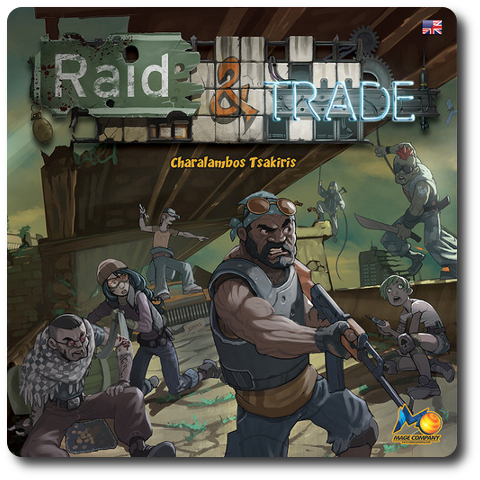
The Basics:
- For ages 10 and up (publisher suggests 12+)
- For 3 to 5 players
- Approximately 90 minutes to complete
Geek Skills:
- Counting & Math
- Logical & Critical Decision Making
- Reading
- Pattern/Color Matching
- Strategy & Tactics
- Risk vs. Reward
- Hand/Resource Management
- Trading
Learning Curve:
- Child – Moderate
- Adult – Easy
Theme & Narrative:
- Live to trade; raid to live!
Endorsements:
- Gamer Geek mixed!
- Parent Geek mixed!
- Child Geek mixed!
Overview
After the third World War came to an end, there wasn’t much of a world left to inhabit. Life became a bitter exercise of survival of the fittest. Large groups built new cities behind giant walls and became the rulers over the wastelands that surrounded them. You live outside one of those city walls and have learned there is a way in. Influential individuals within the city need certain things that they cannot obtain. If you can get them, you’ll be allowed into the city. Easy enough, but others have been offered the same deal…
Raid and Trade, designed by Malte Kühle, Charalampos Tsakiris, and to be published by MAGE Company, will reportedly be comprised of 5 player miniatures, 9 City map tiles, 5 Player boards, an assortment of Resource tokens (that represent clothing, food, weapons, and medical supplies among other things), 4 Black Market tokens, 15 Large House tiles, 15 Medium House tiles, 25 Small House tiles, 1 Outpost token, 10 Large House Raid cards, 15 Medium House Raid cards, 25 Small House cards, 30 Incident cards, 10 Global Event cards, Item cards for the characters, 11 Quest cards, 5 Favor Disc tokens, 5 Combat dice, and 1 Raid die. As this is a review of a prepublished game, I will not comment on the game component quality. I should also note that the component types and quantity listed here will most likely not match the final published version of the game.
Game Set Up
To set up the game, first find the “Black Market” City map tile and place it in the middle of the playing area. Take the remaining City map tiles and randomly arrange them to create a 3×3 map grid with the “Black Market” in the middle.
Second, shuffle the Global Event cards and place the deck face-down beside the City map tiles. Draw the first 2 Global Event cards and place them face-up next to the deck.
Third, shuffle the Incident cards and place the deck face-down next to the City map tiles.
Fourth, shuffle the Quest cards and place the deck-face-down next to the City map tiles. Draw and place face-up 1 Quest card per player.
Fifth, separate the Raid cards into different house type (Small, Medium, and Large) and shuffle. Place each deck face-down next to the game playing area.
Sixth, place the Favor Disc tokens to one side of the City map and place the Resource tokens into a bag (that might or might not be part of the final game) to allow for random token draws.
Seventh, randomly select 1 Black Market token (they are double-sided) and place it in the middle of the “Black Market” City map tile.
Eighth, have each player select 1 miniature and collect all the components that go with that specific character. Set the Skill Point (SP) value to “0” and set the Action Points (AP) to “15” on the Player board. The Favor Points (FP) and Blacklist Points (BP) share the same point tracking wheel. The initial value for these two values is an empty space between the two different points. Place the character miniatures on the “Black Market” City map tile.
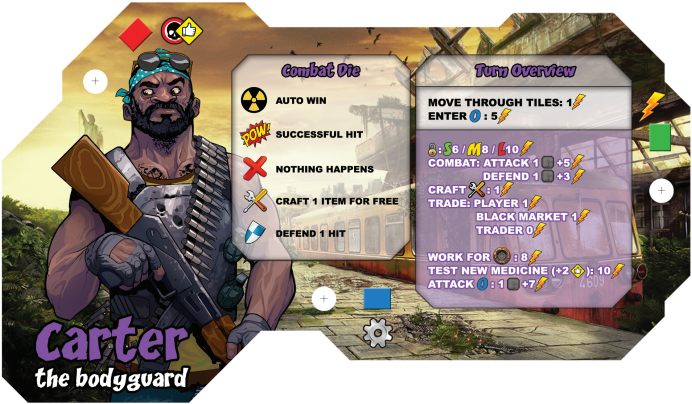
Example Player board without the point wheels
All the different points are important. The Favor Points and Blacklist Points, for example, are used to keep track of what is collectively refered to as “Character Points”. Favor Points increase the player’s Character Points and Blacklist Points decrease the player’s Character Points.
Ninth, determine who will be the first player and then in turn order sequence, place Small, Medium, and Large House tiles on the City map. The number and type of houses is dependent on the number of players in the game.
That’s it for game set up. Time to get raiding followed by some light trading.
Smash and Grab
Note: The game rules have changed several times since we were originally provided the game. As such, some of the rules you will read here will most likely be further refined and defined. Not a lot, mind you, but it’s worth mentioning as I don’t want to mislead you or incorrectly represent the game in its final state. As such, I will only be summarizing the major aspects of the game play, purposely excluding deeper details that are still in flux.
Raid and Trade is played in turns and rounds with no set number of rounds per game. On a player’s turn, they will spend Action Points. The actions available to the player are summarized here and can be taken in any order the player likes, but they always follow the same patter: Movement + Action. After the player takes 1 movement and 1 action (of their choice), their turn is over.
Players can pass on their turn if they like, taking no movement or action. Players must pass if they no more Action Points to spend during the round.
Movement
Players can move their character miniature for 1 Action Point per border or barricade they cross. For example, a player can move to any house on the street they are on without spending any Action Points. However, if there is a fence that divides the neighborhood, the player will have to spend 1 Action Point to hop the fence. If the player runs out of Action Points, but still wants to move, they can discard 1 “Food” Resource to gain 1 Action Point. This can be done multiple times on the player’s turn.
Each time a miniature moves from 1 City map tile to another, an Incident card is drawn and placed face-up on the tile just vacated. Any player can attempt to claim the Incident card, but must not have more than 5 cards in their hand. If the effect on the Incident card is triggered, the Incident card is discarded.
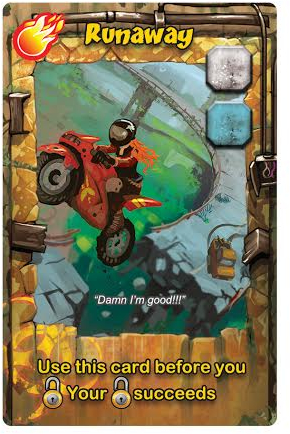
Raid Action
Raiding is the easiest way to obtain resources in the game and the most fun. There is an element of risk, however, but with high risk comes big rewards. Any building the player can get to via movement is fair game, but it will cost the player. A Small House will cost the player 6 Action Points, a Medium House will cost 8 Action Points, and a Large House will cost 10 Action Points.
After the player pays the Action Point cost, they draw a Raid card that matches the building type. The Raid card will either show a die icon or a skull icon. A die icon indicates that the player rolls the Raid die. The Raid die value rolled will determine how many Resource tokens the player draws randomly. There might also be an effect that the player can choose to trigger if they successfully raided. The wording on the effect might also allow the player to choose to trigger the effect or not.
If the skull icon is shown, the player takes the number value shown by the skull and adjusts their Blacklist Points accordingly. The player then takes a number of Resource tokens as noted on the Raid card and resolves the Raid card effect. However, the player can choose not to raid the house when the Raid card is drawn and shows the skull icon. They still have to pay for the Action Point cost, but they gain 1 Favor Point.
After the effect and die roll is resolved, the Raid card is discarded.
Attack Action
If a player can move to another opponent’s miniature, they can attack that opponent. The cost to do so is 5 Action Points and a “Gun” Resource token.
The opponent must now decide if they want to actively defend or not. If the opponent does not, the Combat die is rolled and fate decides if the opponent is hit or not. The opponent wins if the attack missed.
If the opponent decides to actively defend themselves, they must pay 3 Action Points and a “Gun” Resource token. Both the player and the player’s opponent now roll a Combat die. Thematically speaking, they are shooting at each other back and forth.
If the player who attacked wins, the opponent must give up Credit discs and Resource tokens. The player might also get additional items based on their die roll results. Fore example, additional Action Points , Skill Points , and stealing resources.
Craft Action
Resources can be combined to craft much more useful items. Crafting items not only rewards the player with better equipment, but it also adds Skill Points. The cost to craft an item is 1 Action Point and the necessary resources shown on the Item card. Item cards are like blueprints and cannot be used as the item they represent until the resources and Action Points are spent. Then the player takes the Item card and keeps it. Most Item cards can only be used once.
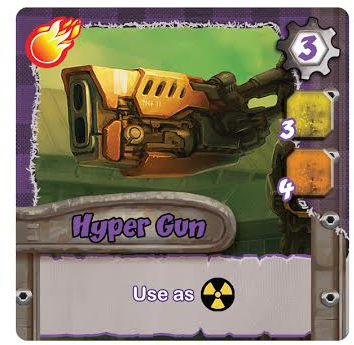
Trade Action
Players can trade Resource tokens and Item cards (that have been crafted or not) to any player in the game. The players who are trading with each other do not need to have their miniatures located next to each other in the game, but they do need to mutually agree on the terms of the trade. The one exception to the location rule is the Outpost that restricts trading. Each trade costs 1 Action Point per player, regardless of the number of tokens and cards exchanged, but only AFTER the trade is completed.
The player can also trade with the Black Market. The player must be standing in the middle of the 3×3 City map tiles (where all players started the game) and pays 1 Action Point for 1 trade. The player then turns in 4 Resources tokens and takes 1 Resource token being offered by the Black Market.
Outpost Action
The Outpost is a special location that allows the player to improve their character and obtain Favor Points. Advancement doesn’t come cheap, however. It will cost Action Points just to enter the Outpost plus the cost of 1 Action Point for movement. Once inside, the player can spend 8 Action Points to get a Credit Disc and Favor Points. Players can also test new medicine for 10 Action Points, being given 2 Favor Points in return.
Finally, the inside of the Outpost offers protection. Players cannot be attacked by players outside of the Outpost. Players can be attacked by other opponents who are also in the Outpost by spending 7 Action Points, however. Attacking is necessary within the Outpost because only 1 player can be in the Outpost at a time.
Complete Quests Free Action
The Quest cards can be claimed by players at anytime if they meet the requirements. Most of the time, the requirement is resource tokens. Once claimed, the Quest stays in front of the player and can be use once per turn.
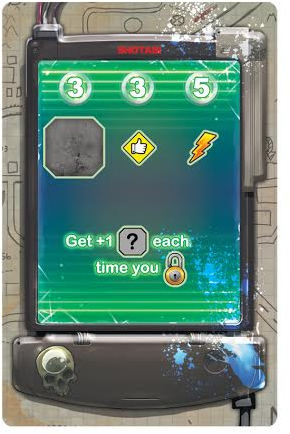
End of the Round
Players continue to move and then take 1 action per turn until all players are out of Action Points. A new round then begins and Action Points are reset (base is 15 AP). The player who collected the least Resource tokens in total is the round’s First Player. The First Player selects 1 of the face-up Global Event cards that remains in effect for all players until the round ends.
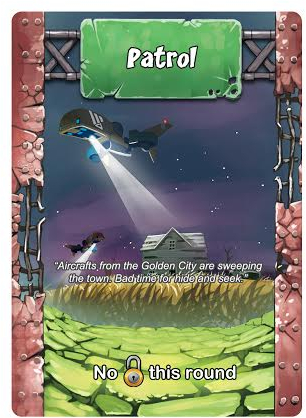
Winning the Game
The game can be won 1 of 3 different ways.
- The first player to obtain 20 Skill Points and spend 20 Action Points wins
- The first player to complete 3 Quests and spend 20 Action Points wins
- The first player to obtain 10 Favor Points and spend 20 Action Points wins
To learn more, visit the game publisher’s web page or visit the Kickstarter campaign.
Final Word
The younger Child Geeks had difficulty managing their characters at first. The “move and then action” turn order was easily grasped, but they tended to lose track of what they were trying to do between turns. According to one Child Geek, “I forgot what I was doing”. This was not the case for smaller games (3 players), but for the largest games (5 players), the downtime was a bit too long for our younger Child Geeks. The older Child Geeks had no issues but were continually frustrated with the random draws of resources. According to one upset Child Geek, “I don’t understand why I can’t just go to a house, spend a lot of AP, and find what I want!” When I mentioned that the game’s narrative suggested that the players are living in a wasteland where they must scrounge for everything, this made them feel better. Finally, one Child Geek said, “I don’t think this is a difficult game, but you do have to keep on your toes. I like it.” He did, some didn’t, and the end result was a mixed level of approval from the Child Geeks.
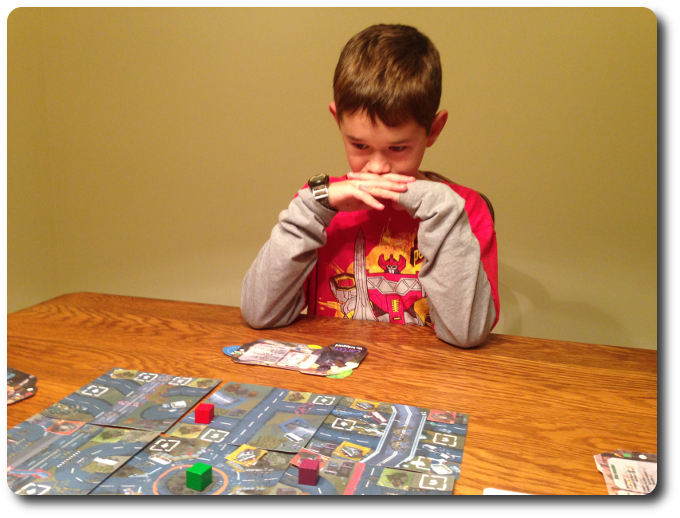
My oldest little geek thinks about his next move while two Gamer Geeks bicker about some game rules…
The Parent Geeks liked the game and the idea of jumping round Parkour style in the ruins of civilization. One Parent Geek said, “What I like most about this game is all the things you can do. Reminds me a bit of the Fallout video games.” A number of the Parent Geeks agreed, including one Parent Geek who said, “Adding in the ability to craft items was a brilliant move.” But the game was a bit to long for the more casual gamers and the non-gamers never found their footing. According to one casual gamer, “The rules are easy enough and the game play is interesting, but I don’t find it interesting enough to spend over an hour running around the same map.” When all the games were over, the Parent Geeks collectively agreed to disagree, providing a mixed level of approval.
The Gamer Geeks enjoyed themselves, but not overly. According to one Gamer Geek, “I don’t know. This game just feels tired to me. I’m not finding it interesting.” Another Gamer Geek said, “You need to trade to win this game, as trading is the most efficient way to get new resources, but if everyone knows that, no one will trade.” One Gamer Geek who really enjoyed himself said, “I like this! I like this a lot! It’s like a treasure hunt in a post apocalyptic wasteland. I keep thinking of the movie Mad Max.” And finally, one Gamer Geek said, “A good enough game. Not the best I’ve played, but not bad. I’d play it again. I hate and love the Global Events, but that’s part of the fun, I suppose.” The Gamer Geeks, like the Child Geeks and Parent Geeks, were conflicted and provided a mixed level of approval.
Raid and Trade is a game that provides a specific kind of game play: Exploration. Exploration games require the player to move around, take risks, poke their noses into areas of the game board they otherwise wouldn’t be interested in, and above all else, work with other players. In Raid and Trade, working together means trading openly and often. Which is hard when you know that every item you are trading could be used to create something against you. But that’s the cost and danger of trading with opponents in general. This means players have to be shrewd, make good trades, and keep on working towards goals no matter what setbacks are put in front of them.
And the players will have set backs, but not the kind that feel horrible. Set backs in Raid and Trade are best thought of a hindrances. For example, if a player is slowed down, that is going to hurt and will most likely result in missed opportunities. As such, players must continually move, move, and move as there’s a lot of ground to cover in the game. It’s the hunt of discovering something unknown and the trill of being the first to find it that drives the game. If players don’t feel that thrill, Raid and Trade fails.
One part of the game that was a surprise to everyone was the Action Points. These are spent continually in the game, and the players quickly learned to budget and plan ahead using their Action Points like money. In fact, a single Resource token that took a lot of Action Points to get was often seen as expensive. I was very pleased to see the Child Geeks count the spaces and then calculate how many Action Points they had to determine if the turn was possible. While Raid and Trade is not “mathy”, players will need to frequently calculate in their head.
I am reserving my own personal judgement on this game for now. It’s not done, in my opinion. There was enough provided to me to teach and play the game, but I don’t want to prejudge a game that is not yet complete. That would be like me telling you if I like what is in the oven before it’s even done being cooked. I have played enough to know that I like where the game is headed, but have no idea if it’ll get there. We’ll just have to wait and see.
This game was given to Father Geek as a review copy. Father Geek was not paid, bribed, wined, dined, or threatened in vain hopes of influencing this review. Such is the statuesque and legendary integrity of Father Geek.




Thank you for the very detailed review and the different opinions you show!
You are very welcome. Thanks for taking the time to leave a comment.